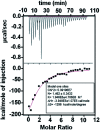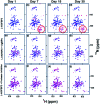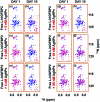Enhanced stability of an intrinsically disordered protein against proteolytic cleavage through interactions with silver nanoparticles
- PMID: 35529627
- PMCID: PMC9071183
- DOI: 10.1039/c9ra05514b
Enhanced stability of an intrinsically disordered protein against proteolytic cleavage through interactions with silver nanoparticles
Abstract
Intrinsically disordered proteins (IDPs), being sensitive to proteolytic degradation both in vitro and in vivo, can be stabilized by the interactions with various binding partners. Here, we show for the first time that silver nanoparticles (AgNPs) have the ability to enhance the half-life of an IDP, thereby rendering it stable for a month against proteolytic degradation. The conjugate of the unstructured linker domain of human insulin-like growth factor binding protein-2 (L-hIGFBP2) with 10 nm citrate-capped AgNPs was studied using two-dimensional NMR spectroscopy and other biophysical techniques. Our studies reveal the extent and nature of residue-specific interactions of the IDP with AgNPs. These interactions mask proteolysis-prone sites of the IDP and stabilize it. This study opens new avenues for the design of appropriate nanoparticles targeting IDPs and for storage, stabilization and delivery of IDPs into cells in a stable form.
This journal is © The Royal Society of Chemistry.
Conflict of interest statement
There are no conflicts to declare.
Figures











Similar articles
-
IGF-dependent dynamic modulation of a protease cleavage site in the intrinsically disordered linker domain of human IGFBP2.Proteins. 2022 Sep;90(9):1732-1743. doi: 10.1002/prot.26350. Epub 2022 Apr 30. Proteins. 2022. PMID: 35443068 Free PMC article.
-
Context-dependent resistance to proteolysis of intrinsically disordered proteins.Protein Sci. 2011 Aug;20(8):1285-97. doi: 10.1002/pro.657. Epub 2011 Jun 8. Protein Sci. 2011. PMID: 21574196 Free PMC article. Review.
-
New Paradigm for Nano-Bio Interactions: Multimolecular Assembly of a Prototypical Disordered Protein with Ultrasmall Nanoparticles.Nano Lett. 2022 Nov 23;22(22):8875-8882. doi: 10.1021/acs.nanolett.2c02902. Epub 2022 Nov 8. Nano Lett. 2022. PMID: 36346924 Free PMC article.
-
An optimized Npro-based method for the expression and purification of intrinsically disordered proteins for an NMR study.Intrinsically Disord Proteins. 2015 Feb 23;3(1):e1011004. doi: 10.1080/21690707.2015.1011004. eCollection 2015. Intrinsically Disord Proteins. 2015. PMID: 28232886 Free PMC article.
-
Intrinsically disordered proteins may escape unwanted interactions via functional misfolding.Biochim Biophys Acta. 2011 May;1814(5):693-712. doi: 10.1016/j.bbapap.2011.03.010. Epub 2011 Mar 31. Biochim Biophys Acta. 2011. PMID: 21440685 Review.
Cited by
-
Carbon quantum dots in bioimaging and biomedicines.Front Bioeng Biotechnol. 2024 Jan 22;11:1333752. doi: 10.3389/fbioe.2023.1333752. eCollection 2023. Front Bioeng Biotechnol. 2024. PMID: 38318419 Free PMC article. Review.
-
IGF-dependent dynamic modulation of a protease cleavage site in the intrinsically disordered linker domain of human IGFBP2.Proteins. 2022 Sep;90(9):1732-1743. doi: 10.1002/prot.26350. Epub 2022 Apr 30. Proteins. 2022. PMID: 35443068 Free PMC article.
-
Modulation of protein-graphene oxide interactions with varying degrees of oxidation.Nanoscale Adv. 2020 Mar 27;2(5):1904-1912. doi: 10.1039/c9na00807a. eCollection 2020 May 19. Nanoscale Adv. 2020. PMID: 36132498 Free PMC article.
References
LinkOut - more resources
Full Text Sources

